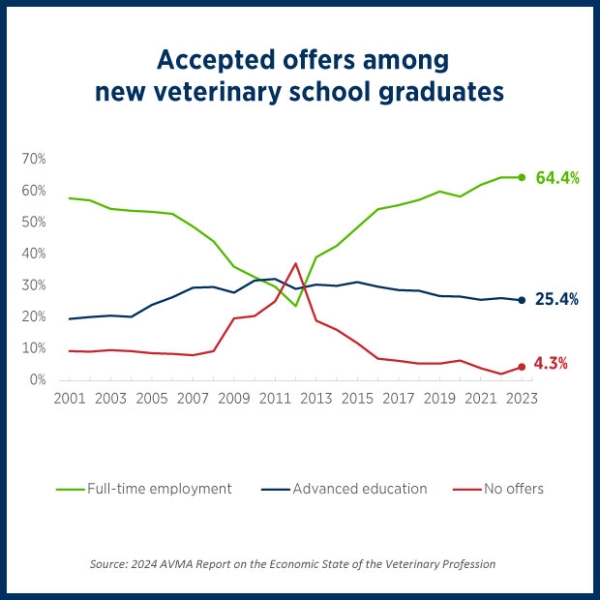Chart of the Month: More veterinarians in the educational pipeline
The number of veterinarians entering the workforce can be anticipated to grow substantively over the next decade as the profession’s educational pipeline continues to expand.
Three new veterinary medical schools are graduating their first classes in 2023, 2024, and 2025, and at least 12 additional schools are in various stages of development. In addition, class sizes in existing U.S. veterinary colleges are growing at an increasing pace.
What the data show
As today’s chart shows, the number of first-year veterinary students enrolled at U.S. veterinary colleges exceeded 4,000 for the first time ever in the 2022-23 school year.
The latest enrollment data from the American Association of Veterinary Medical Colleges (AAVMC) also reveal these additional key points:
- While first-year enrollment has increased an average of 2.0% annually since 1980, annual increases were significantly above that level for the last three years reported: 3.0%, 4.7%, and 3.7% per year for the academic years ending in 2021, 2022, and 2023, respectively.
- These increases reflect larger class sizes at existing veterinary colleges, as well as new veterinary colleges that have begun enrolling students—including the three schools that have graduated or will graduate their first classes between now and 2025.
- Overall enrollment at U.S. veterinary colleges hit 15,157 for the 2022-23 academic year, up from 11,255 in 2012-13.
Read more about the latest enrollment numbers.
What does this mean?
In addition to the larger number of students already enrolled in our veterinary medical colleges, we're seeing a proliferation of newly proposed veterinary schools. A dozen new veterinary colleges have been proposed in the past two years, and some already have secured site visits from the AVMA Council on Education®.
As class sizes grow and new schools continue to come on line, we can expect the veterinary workforce to continue growing in the coming years. That means we’ll be welcoming an increasing number of new colleagues into the profession. The influx of new veterinarians should help ensure an ample supply of veterinarians well into the future.
What can we do with this information?
As we continue looking for solutions to the workforce challenges our veterinary practices face, the news about increasing veterinary class sizes is an important reminder to be mindful in distinguishing between long-term and short-term needs.
We’re seeing dramatic proposals to address our workforce needs by implementing sweeping, long-term changes that would threaten animal health and welfare, patient safety, and public health—for example, a midlevel position that could have non-veterinarians diagnosing, prognosing, recommending treatment, developing herd health plans, prescribing, and/or performing surgery. The data from our veterinary colleges remind us to take a step back, understand the situation fully, and implement responsible measures that meet our workforce needs and protect our patients and public health.
Knowing that we can expect growing numbers of new veterinarians also creates an opportunity for us to plan ahead for their transition into the workforce.
In our individual practices, we can prepare by ensuring that we have strong onboarding programs in place. Take advantage of the AVMA's team-building resources, which include toolkits for training new hires and providing effective performance feedback. And be sure to connect recent graduates with free mentoring through the AVMA’s MentorVet Connect partnership.




Comments
Add New Comment